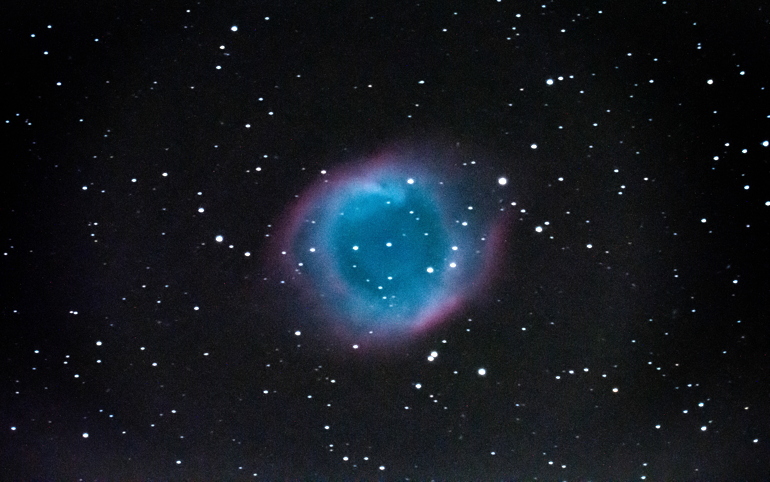Crescent Moon, Einstein Cross, Andromeda Galaxy DSOs,
Helix, Ring, & Dumbbell Nebulae
Posted: 4 October 2016
Sunday, 2 October 2016, was mostly cloudy with three brief rainshowers during the day and evening. Monday, 3 October, dawned partly cloudy with a forecast for a clear night. The sky began to clear mid-day.
|
Open: Monday, 3 October 2016, 1805 MST Temperature: 83°F |
Session: 1017 Conditions: Clear |
Equipment Used:
12" f/8 LX600 w/StarLock
Wireless AutoStar II handset
2" 24mm UWA eyepiece
2" 9mm 100° eyepiece
Camera:
D7200 DSLR
1807 MST: sunset.
1809 MST: LX600 ON, StarLock OFF, High Precision OFF.
1811 MST: viewed the crescent Moon, 102X
1825 MST: Moon and Venus (both left) and the observatory:

Mouseover or tap on image for labels
1832 MST: with the D7200 DSLR mounted at prime focus + focal reducer, took this photo of the Moon, 1/250sec, ISO 400:

A 1 second exposure showing Earthshine and some stars:

1913 MST: removed the camera and viewed Venus, 102X, very low in the western sky. Seeing was not good but the gibbous phase was visible. Then viewed Saturn, 102X. Seeing was not good at Saturn either as it was low in the sky. The moons Titan, Rhea, and Tethys were visible. The moon Dione was lost in the planet's glare. The view of Mars, 102X, was also not very good. 1923 MST: viewed NGC7293 (Helix Nebula), 102X, but it was too low in the southeastern sky for a good view.
Next, I slewed to the location of the "Einstein Cross" (RA 22h 40m 30s, DEC +03° 21' 31", Mag +16.78, size <2 arcsec). Set up to try to image it at prime focus. I had been successful at capturing the "Einstein Cross" using the 8" LX200-ACF on 9 October 2015. 1932 MST: High Precision ON. After doing a focus test image and SYNCing on the star Markab, slewed to the RA/DEC for the object. 2003 MST: StarLock ON. This is a 5 minute, ISO 6400, StarLock autoguided, exposure with the location of the "Einstein Cross" marked:

There are also a few small faint galaxies visible in the image. Unfortunately, poor seeing apparently affected the autoguiding and so there was some image trailing. Will try again on a future session.
Next, slewed to NGC206 (star association in M31, Andromeda Galaxy). Took this StarLock autoguided, 5 minute, ISO 6400, image showing NGC206 and G76 (globular cluster in the Andromeda Galaxy):

Mouseover or tap on image for labels
2102 MST: added the focal reducer and took this 3 minute, ISO 6400, StarLock autoguided, image of NGC7293 (Helix Nebula):

Some trailing occurred.
Removed the focal reducer and added the 2X PowerMate. Took these photos:
M57 (Ring Nebula), 1 minute, ISO 6400

M27 (Dumbbell Nebula), 5 minutes, ISO 6400

Again, some trailing occurred. Will redo on a future session.
2216 MST: ended DSO imaging. StarLock and High Precision OFF.
2229 MST: viewed M27 (Dumbbell Nebula), 102X. Pretty.
For the last few sessions the AutoStar GOTOs had been not as good as they should have been. So I did a new One Star Alignment. To verify that GOTOs were now improved I did GOTOs and viewed M57 (Ring Nebula), M15 (globular cluster), and M31 (Andromeda Galaxy). All GOTOs were good. The M15 globular cluster was a fine view at 102X.
2243 MST: viewed the planets Neptune and then Uranus, 102X. This was a five planet viewing night.
2250 MST: back to M31 and viewed NGC206 in the Andromeda Galaxy. Switched to 271X and using averted vision, the G76 globular cluster (Mag +14.2) in the Andromeda Galaxy was easily seen.
Also viewed M1 (Crab Nebula), 102X, very low in the eastern sky. It was not a great view (too low) but still nice to view.
The last object viewed this session was the Double Cluster, 102X. It is always a pretty sight. Both open star clusters were visible in the same field-of-view.
|
Close: Monday, 3 October 2016, 2329 MST Temperature: 57°F |
Session Length: 5h 24m Conditions: Clear |
Comments are welcome using Email. Twitter users can use the button below to tweet this report to your followers. Thanks.
Cassiopeia Observatory Home Page
Copyright ©2016 Michael L. Weasner / mweasner@me.com
URL = http://www.weasner.com/co/Reports/2016/10/04/index.html
